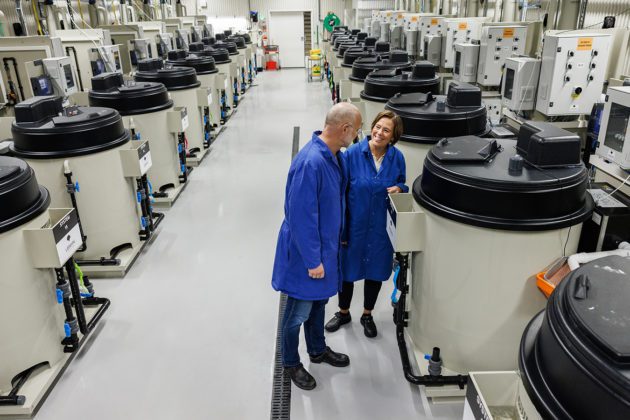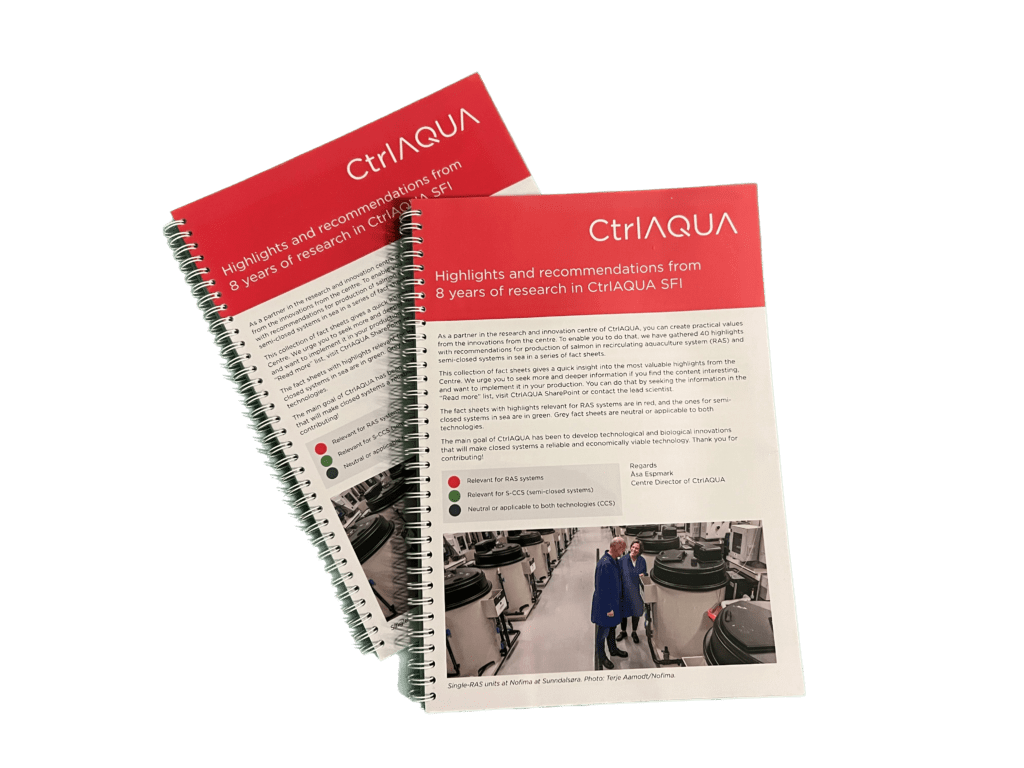42 highlights from research on closed aquaculture systems

In order to have impact on the development of aquaculture, the applied knowledge we create need to have practical use. Here is a collection of 42 fact sheets from 8 years of research in CtrlAQUA.
From 2015 to 2023 Nofima hosted the Centre for Research-Based Innovation (SFI) in Closed-Containment Aquaculture – CtrlAQUA.
The main goal of CtrlAQUA was to develop technological and biological innovations that will make closed systems a reliable and economically viable technology.
Now you can create practical values from the innovations from the centre.
Nofima
Together with our partners in industry and research, we have created a lot of knowledge. Now you can create practical values from the innovations from the centre. To enable you to do so, we have gathered 42 highlights with recommendations for production of salmon in recirculating aquaculture system (RAS) and semi-closed systems in sea in a series of fact sheets.
Partners
The Centre was financed by the Research Council of Norway and partners. It was led by Nofima, in collaboration with NORCE, NTNU, the University of Bergen, the University of South-Eastern Norway, Freshwater Institute
This collection of fact sheets gives a quick insight into the most valuable highlights from the centre. But beware, we are presenting highlights and recommendations without much information on the premises behind the research. We therefore encourage you to seek more and deeper information if you find the content interesting and want to implement the research in your production. You can do that by seeking the information in the “Read more” list or contact the lead scientist.
The fact sheets with highlights relevant for RAS systems are in red, and the ones for semi-closed systems in sea are in green. Grey fact sheets are neutral or applicable to both technologies.
The recommendations from CtrlAQUA
Relevant for RAS-systems
- Post-smolt performance in seawater; effect of winter signal, salinity and timing of sea transfer (pdf)
- The effect of timing and length of a winter signal in RAS and size at transfer on post-smolt performance in seawater (pdf)
- Importance of osmoregulatory capacity in gills, intestine and kidney before seawater transfer (pdf)
- Responses in osmoregulatory capacity in gills, intestine and kidney before seawater transfer (pdf)
- Smoltification protocol for autumn transfer (pdf)
- Smoltification protocol for spring transfer (pdf)
- Carbon dioxide limits for Atlantic salmon (pdf)
- Salinity acclimation strategies for RAS bioreactors (pdf)
- Use of ozone in brackish water RAS: Benefits and risks for post-smolt Atlantic salmon (pdf)
- Disinfection in Atlantic salmon RAS – current knowledge that requires a revisit (pdf)
- Effects of light quality and intensity on fish performance and changes in intensity and spectral composition of light in RAS (pdf)
- Photoperiod, temperature, and fish size effects on prevalence of early puberty in post-smolts (pdf)
- Effects of photoperiod and feeding intensity on prevalence of early puberty (pdf)
- The optimum water velocity for Atlantic salmon post-smolts in RAS is close to one body length per second (pdf)
- Nephrocalcinosis – initial CtrlAQUA survey (pdf)
- New membrane for CO2 sensor (pdf)
- Does peracetic acid impact the quality of dissolved organic matter (DOM) in RAS? (pdf)
- Does ozone impact the quality of DOM in RAS? (pdf)
- Does the type of feed induce changes in the DOM composition of RAS waters? (pdf)
- Peracetic acid – a sustainable disinfectant for Atlantic salmon post-smolts (pdf)
- Recommendations for production of Atlantic salmon postsmolt in RAS (pdf)
- Optimizing CO2 degassing in RAS (pdf)
- H2S risk in RAS (pdf)
Relevant for S-CCS (semi-closed systems)
- Importance of an intact skin (pdf)
- Skin immune readiness in postsmolts (pdf)
- UV requirements for inactivation of viruses, bacteria and sea lice (pdf)
- Ultrafiltration membrane removal of viruses and bacteria (pdf)
- Microparasites in semi-closed system in sea (pdf)
- Thermal optimization of post-smolt on- and off-season transfer and rearing strategies (pdf)
- Field diagnostics of nephrocalcinosis in farmed Atlantic salmon by using radiography (pdf)
- Review of technologies for intake water treatment in S-CCS (pdf)
- Growth performance and welfare of post-smolt reared in semi-closed systems in sea – a comparative study (pdf)
- FishGLOBE – technology for sustainable production of postsmolt (pdf)
Neutral or applicable to both technologies (CSS)
- Wound types and regeneration (pdf)
- Energy status after seawater transfer in Atlantic salmon post-smolts with different life history in RAS (pdf)
- Photoperiod condition for robust smolt in FW (pdf)
- Optimal temperature conditions for robust smolts (pdf)
- Optimal salinity during postsmolt stage (pdf)
- Automatic on-site real-time identification of any disease in fish and production water (pdf)
- Diagnostics of immune competence of Atlantic salmon smolts and growers: multigene assay (pdf)
- Using molecular biomarkers in the kidney for early detection of nephrocalcinosis in Atlantic salmon (pdf)
- Antibiofouling coatings for sensors (pdf)
- Automatic micro-based sensor system for trace metals (Zn, Fe, Cu) (pdf)

View the whole collection of fact sheets
The 42 factsheets are gathered in a pamphlet:
